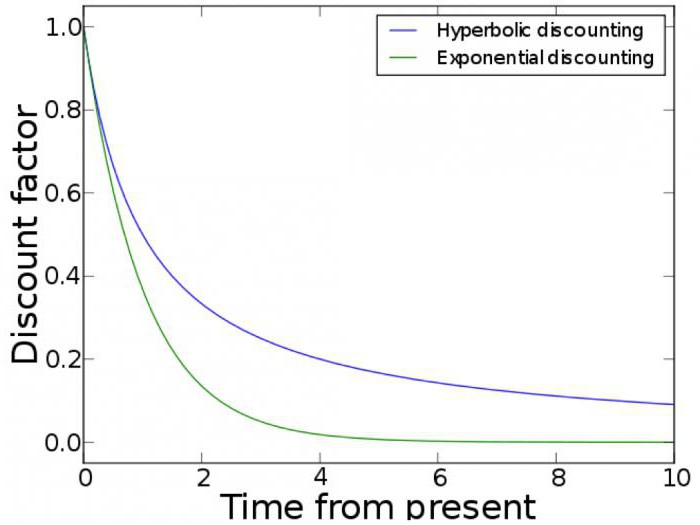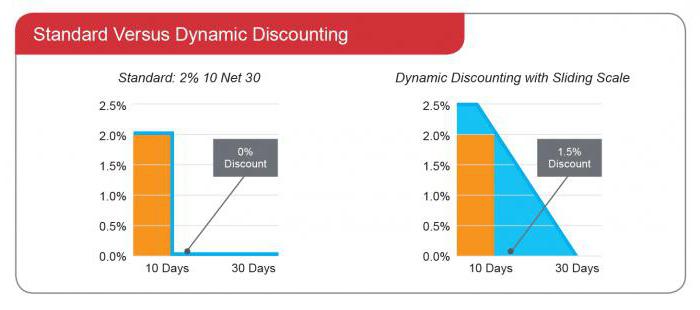Discounting is financial mechanism by which the borrower receives the right to defer payments to the creditor for a certain period of time in exchange for an additional percentage. In essence, this means that the party that owes the money buys the opportunity to give it to the borrower in the future. This mechanism helps the redistribution of free cash resources, ultimately contributing to the development of the economy.

Basic concepts
Discount is the difference (expressed in absolute or relative terms, or using an index) between the initial money that must be given to the borrower in the present and the amount of debt to be repaid in the future. Since the borrowing party incurs losses (inflation plus the possibility of alternative incomes) in connection with the postponement of return, this financial mechanism involves an additional percentage for the delay in the initial contract.
Discount rate
Accounting for the time factor implies the need to compare the amounts in different periods. We all understand that one thousand dollars now and in a month are two different amounts. The discount method involves bringing future income to date. For this, a special coefficient (kd) The discount formula will look like this: P = F x Kd, where P is the sum brought to the present, F is future income. K coefficientd equals 1: (1 + i)n. In the last formula, i is the interest rate and n is the period number. The inverse of this indicator is the accumulation coefficient, which is used to bring these amounts to future periods. In this case, F = P x (1 + i)n. Thus, the discount rate allows you to understand how much interest you need to increase the interest on the loan.

Task example
Consider the application of the formula for a specific example, that is, discounting projects. For example, we are offered $ 100 in five years, or 50 now. What to choose? Experience suggests that the latter option is better, but in fact, not everything is so simple. Let's calculate what the future amount in the present is equal to. To do this, calculate the discount factor. For this we need an average interest rate. Let's say it is 12%. The coefficient will be equal to (1 + 0.12)5 = 1.76. This means that 100 dollars in the future are 56.74 in the present. Thus, common sense was wrong, it is better to choose the first option.

Discount function
Comparison of present and future earnings, taking into account the time factor, can be done using a graph. The discount function is used in economic modeling. Utility also decreases with time. Exponential and hyperbolic discounting are the two most frequently described examples. The first case is based on the proposition that the marginal rate of substitution between consumption levels at different points in time depends solely on how far they are. Therefore, it is often considered dynamically inconsistent. Exponential discounting is a method that allows you to compare the adequacy of a choice based on a time factor. It was widely used due to its simplicity. However, hyperbolic discounting is a more accurate method. Popular wisdom says that a tit in the hands is better than a crane in the sky. But in practice, we often observe that it is difficult for us to postpone the receipt of debt for a week, but the difference between the agreement to give it back after eight or nine months seems hardly noticeable.The advanced discounting method takes this human feature into account.

Practical value
Why is a thousand dollars now better than a similar amount, but in the future? All this is due to the fact that the money received at the moment could be invested in other assets. Therefore, the postponement of debt repayments is inextricably linked to such a financial mechanism as the discount operation. The concept is associated with the concept of opportunity cost. A delay in payment means that a person cannot use his money for a certain period. The debtor actually compensates for these opportunity costs.

Features of the calculation
The rate of return is calculated in accordance with the annual return on investment. Since you can get interest on the amounts already received as a result of previous investments, current income always looks better than similar money in the future. Thus, the discounting of capital implies a decrease in capital in accordance with the reduction to date. Businessmen like to repeat that time is money. And this everyday wisdom is confirmed by the discount formula. The price of money today and tomorrow are not the same values. If the debtor cannot give the right amount now and is negotiating to postpone the date of its return, then he should be prepared for the fact that he will have to cover the lender's opportunity costs by paying an additional percentage.
Discount rate
Market pricing is a complex process that depends on many factors. One of them is discount rate. It is believed that it should be chosen in such a way as to meet the cost of capital. The latter concept is inextricable with the rate of return. Of course, it should be adjusted for risks. Discount rates that apply to companies can vary significantly:
- Startups in search of investments - 50-100%.
- They are in the early formation period - 40-60%.
- Startups established in the market - 30-50%.
- Mature companies - 10-25%.
A higher level of discount rates for startups reflects the problems associated with them:
- Compared to mature sales, the eligibility for the sale of property rights is lower since their shares are not traded on the stock exchange.
- A limited number of investors.
- High risks.
- Overly optimistic forecasts of the enthusiastic founders.

Asset pricing model
In order to determine the profitability of capital in the future, which is especially important for potential investors in startups, three indicators are used, based on which the discount rate is estimated. Among them:
- Risk free rate. This is the percentage return on investing in safe financial instruments, such as government bonds.
- Bet Bet This is an indicator of how company stock prices respond to changing market conditions. If this rate is more than one, then we are dealing with a financial bubble. Less - stock prices go against the market.
- Risk premium. This is a return on the investment that investors need in normal conditions.
In this case, the discount rate is the sum of the first indicator and the second multiplied by the third. Its application is the key to investment efficiency.








